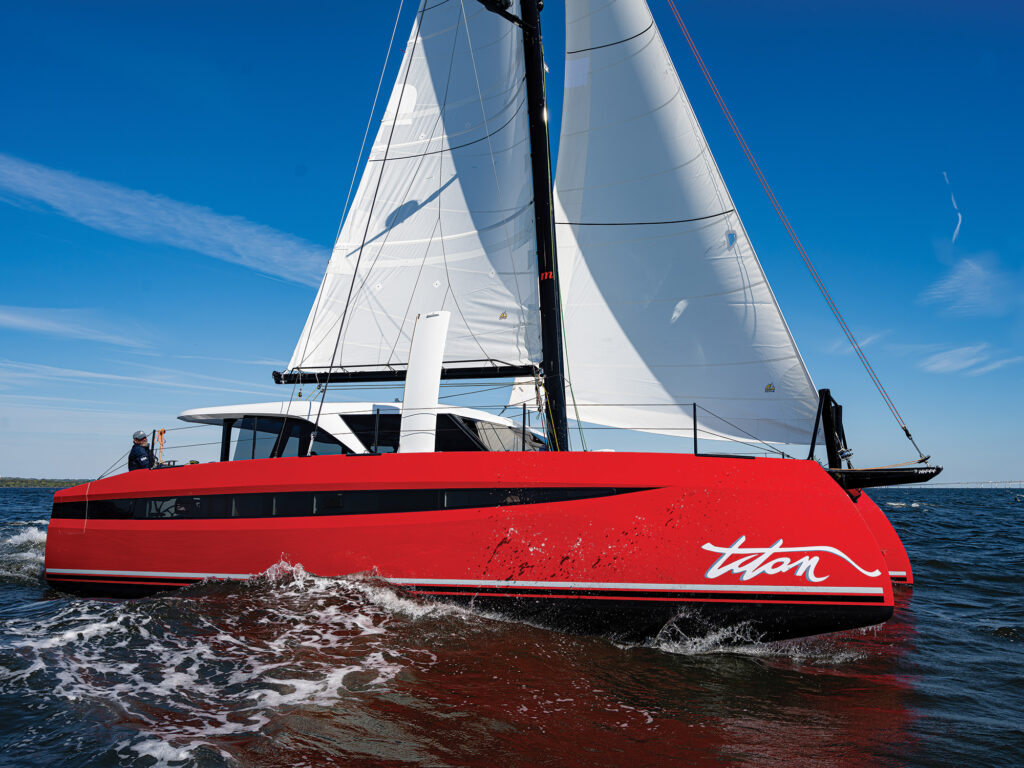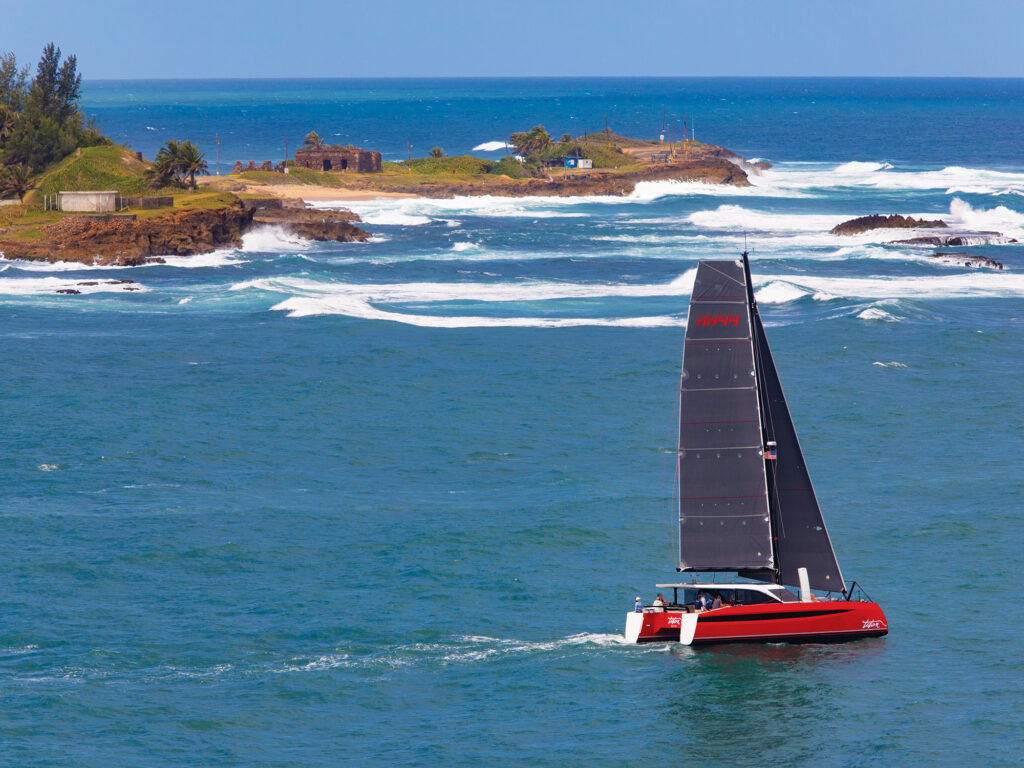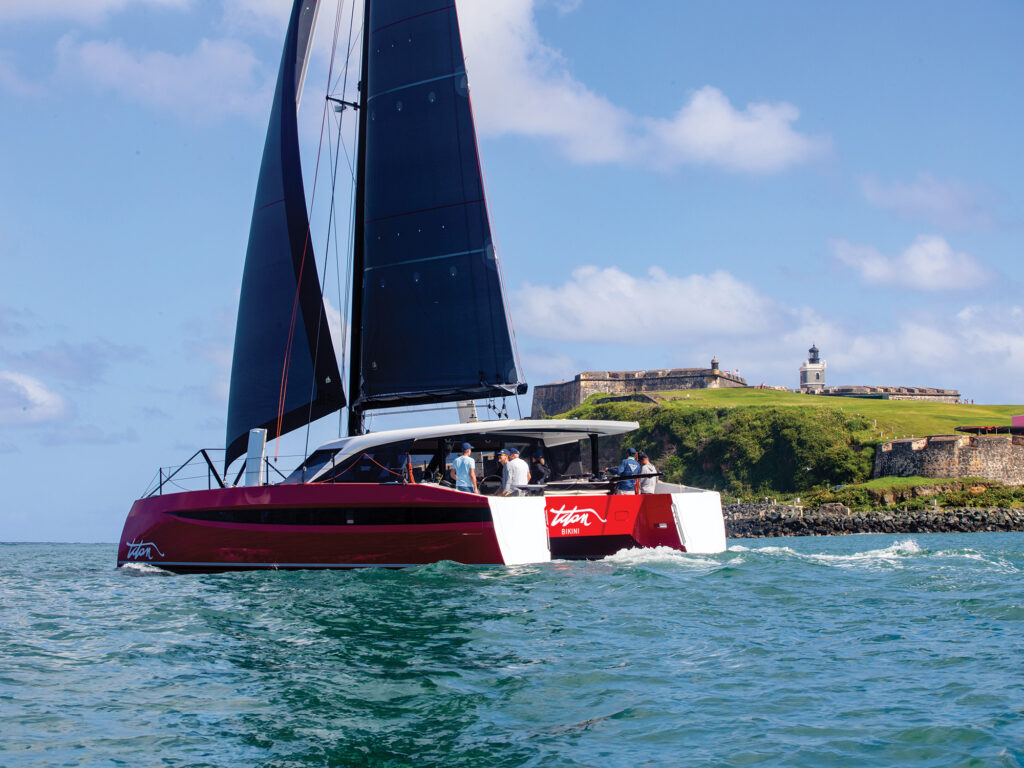
There are many outstanding, even outrageous, things one can say about the HH44-SC catamaran. It’s the latest in a series of upscale boats conceived by HH CEO Paul Hakes, with structural engineering by the naval-architecture duo of Melvin & Morrelli and built in China by the Hudson Wang manufacturing conglomerate, which sold more than three dozen hulls on drawings and renderings alone, before a single boat was built. The waiting list is now about two years long.
I’m no math whiz, but with the boat’s sticker price, all up, of over $1.6 million, it’s safe to say that HH Catamarans had something like $50 million of orders on the books in advance of a sole customer actually pushing the button on an electric winch to raise the hefty, full-battened mainsail. Which leads to a pretty simple question: Who are those guys?
In an interview I conducted with Morrelli several years ago, he spoke about the sort of buyer drawn to the HH brand: “It’s unbelievable to me the percentage of newbie owners we attract to HH. More than 50 percent are first-time boat owners, guys who are buying $2 million and $3 million boats. I find that a bit shocking, but they were successful at something at some point in their life, and they’re trying to roll that success and confidence into something else.”
Allow me to take that one step further, because I’ve met a few HH owners, and I believe that the boat is catnip to a certain type of tech-savvy consumer. They definitely find the boat’s clean lines and tantalizing performance sleek and sexy, but they also are passionately drawn to the forward-thinking technology itself. I’ve heard folks refer to certain products in the marine sector as something Elon Musk might’ve dreamed up, but the HH44 may in fact be the closest thing there is to a Tesla of sailboats. I’d bet dollars to doughnuts that more than a few HH owners have one of those parked in their driveway.
What, exactly, are those folks getting for their seven figures? There are two versions of the boat: the HH44-OC (Ocean Cruising), a dedicated bluewater cruising cat with mini keels instead of daggerboards; and the HH44-SC (Sports Cruising), a no-holds-barred rocket ship with C-shaped carbon boards, a solar array, and the company’s EcoDrive auxiliary propulsion package, which we’ll delve into shortly. The SC is the model we tested for the 2024 Boat of the Year contest. Spoiler alert: We were fairly blown away by the boat, and honored it with a Judges Special Recognition Award. Our sister publication, the performance-oriented Sailing World, named it overall Boat of the Year and described it as “the performance sailor’s retirement race boat.”

Aesthetically, in theme and execution, the HH44-SC presents a futuristic appearance. There’s a fixed bowsprit forward; ample freeboard in the relatively narrow hulls (at least compared with your average cruising cat from mainstream builders); a slash of integrated hull windows that offer natural light in the staterooms and double as a nice visual accent; a pair of drop-down swim platforms in the transoms; and a set of dinghy davits in between. The coachroof extends well aft and doubles as a hardtop Bimini over the cockpit, while serving as the base for the traveler and mainsheet arrangement, and as the base for more than 4,000 watts of mounted solar panels.
Quick aside: The hulls are painted, and I reckon that more than a few owners will go with colors not usually found in genteel yacht surroundings. Our test boat, Titan, the first HH44-SC off the line, is bound for the Caribbean with a magnificent bright-red exterior. The intent is clear: You can go garishly or go home.
Forward-facing windows in the main cabin can be opened to allow the fresh breeze to course through. M&M employed forward cockpits for steering and sailhandling in many of their previous designs, but eschewed that layout here. Instead, there’s a set of Jefa helm stations well aft that can rotate outboard for increased visibility when driving upwind, or that can be tilted inboard under the Bimini top in inclement conditions or to access line handling by gaining proximity to the winches. It’s a versatile, well-reasoned solution that I like a lot. I wish more cats were laid out similarly.
Below, a dedicated en suite owner’s stateroom runs the length of the starboard hull. A pair of double-berth staterooms to port share a central head and shower.
So, that serves as the basic overview of the 44-footer. But what about the technology? The big stories there are the propulsion and construction.
The most eye-opening feature is the hybrid auxiliary setup. Boat of the Year judge Tim Murphy is the educational director for the American Boat and Yacht Council and our go-to expert for all technical matters. Here’s his take on the system developed by UK firm Hybrid Marine: “It had the most sophisticated house systems and propulsion we’ve seen in the contest, starting with their parallel hybrid drive, a system unlike any we’ve inspected on any boat before this one.”
Electric motors are built onto the back of the twin 30 hp Beta Marine diesels (or optional Yanmar 40 hp engines) with a coupling to the transmission. The electric motors can effectively be used as a pair of 5 kW generators to charge the battery bank. Adding regeneration while sailing provides up to 2 kW per shaft at 10 knots of boatspeed. An additional 43 kWh of energy is produced by the solar array on the cabin top.

What this translates to is silent operation under power in full electric mode, augmented by hydrogeneration to top off batteries while sailing, with the good old-fashioned reliability of those diesel engines as a backup, or for motoring through high pressure on passages.
It’s a boat that covers a lot of bases, though Murphy is also quick to note that it will be interesting to see how all this translates to real-world operations, given that it’s new tech. He wouldn’t be surprised if, at the outset, there are growing pains bringing it all online (though company representatives note that the system has been used in European canal boats for more than 10 years).
HH president Seth Hynes says: “At full battery capacity, you can run the boat at full throttle using the two 10-kilowatt electric motors and get 7 knots of boatspeed for approximately two hours. In light air, you can even keep your leeward electric motor running to build yourself some apparent wind.”
Murphy is also impressed with the build quality: “It’s thermal-foam construction with panels of Corecell foam core that’s heated up to make the complex shapes of the hull with no slits or kerfs in between. So you’re using those flat sheets to construct complex curves, and then you’re using the best resin available—which is epoxy—in the laminate, which also employs carbon cloth. This is infused epoxy construction, post-cured after that fact, so they are very, very high-quality hulls.”
Carbon reinforcements are also used in high-load areas such as the wing deck, coachroof and daggerboard trunks. The Marstrom rig on the HH44-SC is all carbon (the OC version has a standard aluminum mast with the option to upgrade).
At the end of the day, the reason one is attracted to a light, fast cat is pretty simple: performance. HH has been well-represented in previous Boat of the Year competitions, with its HH66, HH55 and HH50 all previous nominees (the latter two won awards in 2018 and 2021, respectively). To be honest, I’ve always been startled by the fact that many of these cats have gone to first-time boat owners with varying degrees of experience. I’ve been sailing for decades, and I’d be fairly intimidated to head offshore with a shorthanded crew on the larger HH cats, which are not simple vessels, but rather extremely powerful boats where things can escalate quickly if the first domino falls.
One doesn’t need to be Superman, however, to sail the scaled-down HH44. Our test boat arrived in Annapolis, Maryland, with only a set of basic working sails (main, self-tacking staysail), so we didn’t get the full-on, off-wind power-reaching sleigh ride that is essentially the boat’s reason for being, but the sailing was still fast and sprightly. (A hat tip to the HH commissioning team, who had the boat sailing just two days after it was offloaded from a freighter in New Jersey.) Closehauled, with the deep, nearly 10-foot boards deployed, the boat tracked like a train and quite easily flirted with 10 knots of boatspeed. I can only imagine what it would be like to set a kite, then turn and burn, but it’s safe to say that you’ll regularly be registering double-digit boatspeeds. HH reps say that our test boat hit 23 knots on the delivery south to the Caribbean.
All in all, the HH44-SC is quite a machine to behold. The story of production-boat building, starting way back in the 1960s, has been an ongoing evolution—piece by piece, boat by boat. Now this very cool cat has penned its own chapter. There’s really nothing else like it.
Herb McCormick is a CW editor-at-large and was a 2024 Boat of the Year judge.
FYI
The “HH” in HH Catamarans represents the initials of Chinese businessman and manufacturer Hudson Wang, who founded the company, and CEO Paul Hakes, a New Zealand boatbuilder who joined forces with Wang in 2012 to launch the brand. There are currently eight models in the HH lineup, ranging in size from 44 feet to 88 feet, including the HH50, which was named the Best Luxury Cruiser in the 2021 Boat of the Year contest. The HH Catamarans design team of Melvin & Morrelli is well-known for their America’s Cup contenders, maxi offshore cats such as the 125-foot PlayStation, the pioneering Gunboat cruising cats, and the current line of Rapido performance trimarans.








